HLA 300, A CLOSE SURVEY OF THE HF AMPLIFIER
![]() 10-oct-2016: Mix 43 trafo's
10-oct-2016: Mix 43 trafo's

RM Italy HLA 300 linear HF amplifier, HLA 300 schematic version 1.20 version 2.00
INTRODUCTION
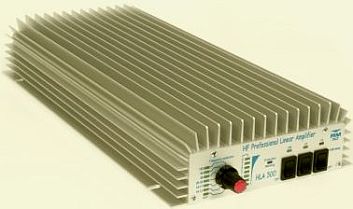
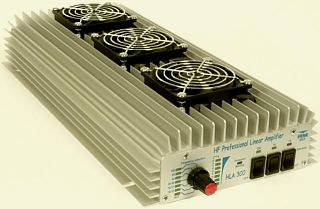
All the technical details of this amplifier can easily be obtained from the internet. In this survey some practical experiences were written down, that might become handy in case you're contemplating purchasing such an amplifier.
Attention, there are two versions of this amplifier with the type-id HLA 300 on the front-cover of the amp.; with or without air-ventilators. If the HLA 300 V is mentioned, we are talking about the version with the ventilators. In my opinion this cooling is a necessity and operates very well, so it would be a wise decision to choose the latter. On stand-by the vents operate allmost noiseless, and on transmit they immediately will kick-in.
The amplifier is neatly of construction, has adequate internal safeguards which will warn you by a buzzer, and what is more important: the amplifier is able to withstand excessive drive-power for a short period (a couple of seconds) of time.
Transmitting power according to the manufacturer (RM Italy www.rmitaly.com):
CW: 300 W output at 1 - 15 W input,
SSB: 550 W output at 2 - 20 W input.
On my request PH4U/DC2DC tested his HLA 300 transistor amplifier, an all-band/all-mode type which runs at 12 - 14 V/45 A. His practical test-results, is in my opinion informative for other hams.
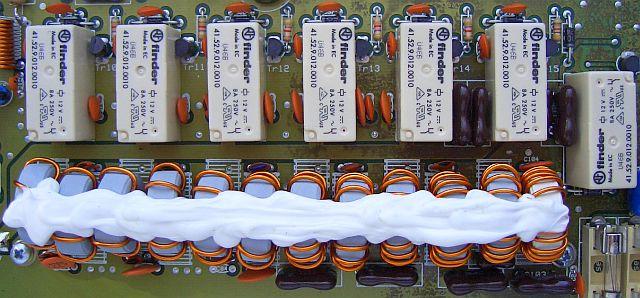
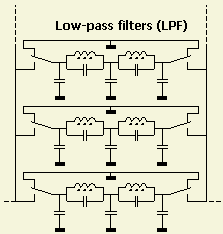
In contrast with many similar products, which are lacking of some filmtering, this amplifier has 6 low pass filters (LPF's)installed, covering 9 HF bands.
TEST CONDITIONS
Amplifier: HLA 300 (4 × SD1446, forced cooling by triple ventilators); power consumption is about 550 - 600 Watt.
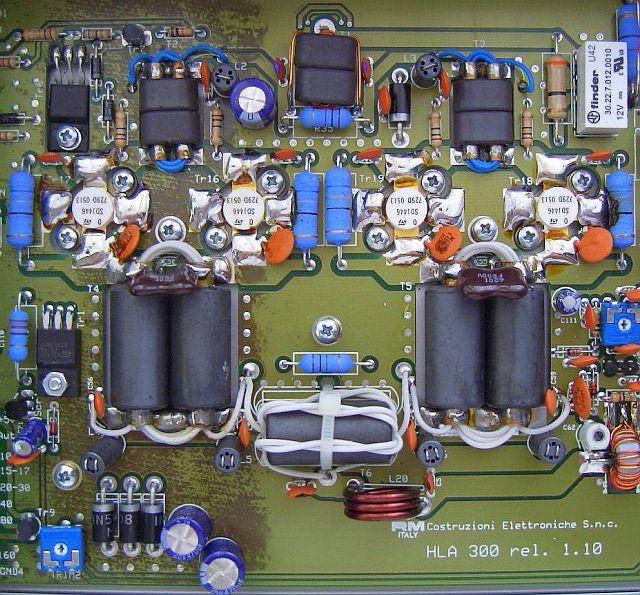
4 × SD1446.
|
Power supply: Exciter: Low Pass filter: SWR/PWR meter: Dummy load: Cables: SSB mode: |
SPS-9600, 13.8 V (switching PS, 0.8-15.4 V/60 A). Kenwood TS-570D with its own power supplies. Kenwood LF-30A. Daiwa CN-101L, 1.8-150 MHz 15/150/1500 Watt. MFJ-264, 1500 W for 10 seconds, dries load type. Each cables about 3 ft Aircell 7 with PL connectors. Speech at a normal level. |
|
A speech-processor wasn't used, and is not advised because of the bandwidth of the amplified signal. Daniël commonly doesn't exceed 20 Watt of input power in SSB.
MEASURED VALUES

PCB.


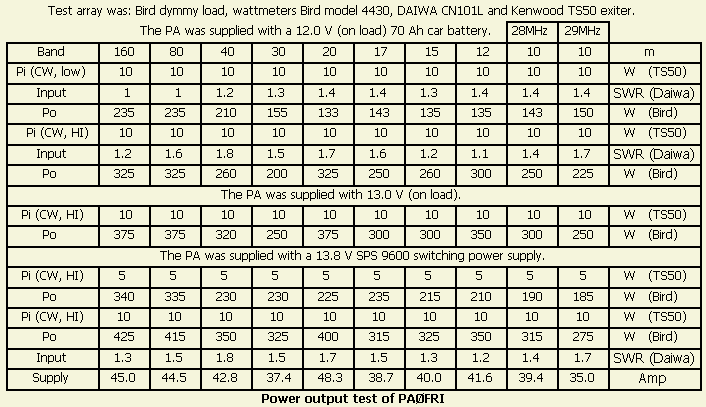
K6AER also reviewed in detail a HLA 300 and his power output test is showed in the middle table. Please note that this power supply voltage is higher. A higher voltage as well as the diameter of the supply cable can make quite a difference in voltage and/or amperage.
Meanwhile PH4U was able and willing to lend me his HLA 300, to play around with. At that moment his SPS 9600 power supply had some troubles. For the time being I had to use a car-battery of 12 V/70 Ah, which produced, fully charched and under load of the amplifier, exactly 12 V. The HLA 300 was driven at 10 W, first with its internal attenuator on, later without the attenuator. Then the battery voltage was increased to 13 V under load. On average the output power did increase with about 50 W (see fig.) Later the problem with the SPS 9600 was fixed was set for 13.8 V. The test was repeated, this time with 5 W and 10 W drive. The bottom lines of the measurements show the results.
Note: A 1-Volt drop can easily occur with these high currents (here 45 - 55 Amps) when (to) long or (to) thin leads are used.
MODIFICATION ?
|
The average performance increased with the deleted 100 pF capacitor.
With 5 W drives the unchanged (except a deleted 100 pf cap) amplifier gave the best results. |
Almost immediately after publishing the Dutch version of this topic, questions from abroad arose, such as: is there a way to drive this linear to its full potential with an input of let's say 5 Watt (FT-817).
For a better overview the two positions of relays RL1 are drawn (fig»), including the converted resistors. For a drive of 5 W, one can replace all the original resistors, but putting-in parallel resistors instead is much easier to experiment and getting things back in original condition again. The capacitor of 100 pF wasn't drawn in the schematic, however it was mounted in the amp. While testing it showed that the 100 pF capacitor in this specific amplifier better could be taken out to improve performance.
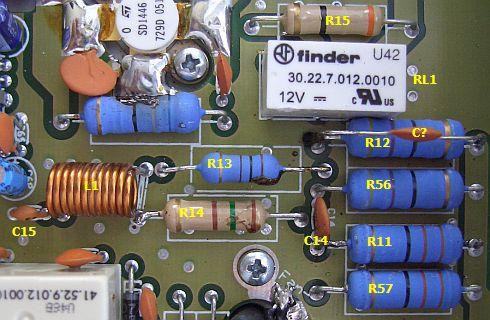
Because the loaned equipment (PA + PSU) I was able to do more experiments. The attenuator was changed several times in order to allow less input (5 W) drive. However corresponding SWR was subpar or bad. Changing the values for better SWR resulting in less power than the original attenuator.
Finally maximum power was achieved with 5 W drive and unchanged attenuator.
Conclusion: 5 W are too low to drive this HLA 300 to its full potential. The only solution is to use an extra amplifier stage, which can lift the FT-817's power level up to 20 W.
OUTPUT TRANSFORMERS
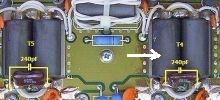 This amplifier has two pairs of transistors working in balance and both pairs are coupled with splitters. How harmful this is or could be for the equipment, I don't know, but after a few minutes transmission with FM or CW carrier, the ferrite-tubes (fig») of both output transformers got warm, up to hot. You can burn your fingers on them. If it was my own homebrew PA, I would have changed the ferrite tubes for a bigger size. Remarkably the right tubes getting the warmest. Perhaps beause at this transformer only one end of the five turns is connected to ground. So the oupput stage is not really symmetrical and that could explain the difference.
This amplifier has two pairs of transistors working in balance and both pairs are coupled with splitters. How harmful this is or could be for the equipment, I don't know, but after a few minutes transmission with FM or CW carrier, the ferrite-tubes (fig») of both output transformers got warm, up to hot. You can burn your fingers on them. If it was my own homebrew PA, I would have changed the ferrite tubes for a bigger size. Remarkably the right tubes getting the warmest. Perhaps beause at this transformer only one end of the five turns is connected to ground. So the oupput stage is not really symmetrical and that could explain the difference.
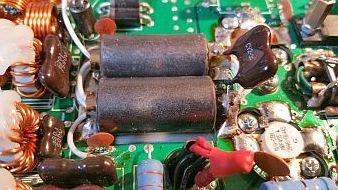
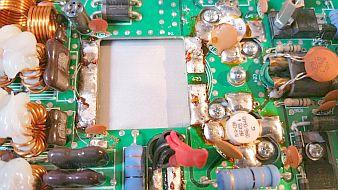
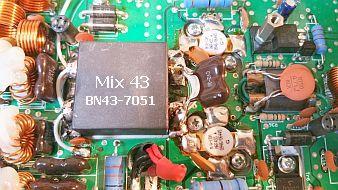
PA1HR removed in his HLA 150 the output transformers and replaced with BN43-7051 (mix 43).
Because hot transormers in PA1HR's HLA 150, he replaced them with type BN43-7051 (mix 43). A two-tone test showed that distortion was significantly reduced after his modification as the image on a spectrum analyzer shows!
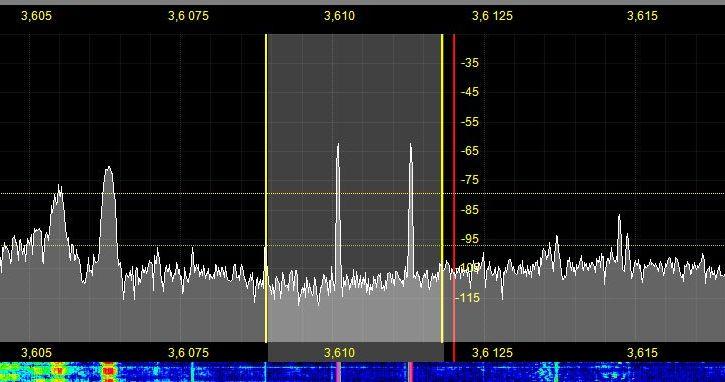
The analyzer shows a two-tones image after installation of mix 43 transformers in a HLA 150.
INPUT SWR
 |
 |
The SWR on the input of this HLA 300 could still be slightly improved by adding an extra capacitor parallel to respective C50 (620 pF) and C55 (620 pF). Apparently RM Italy has been experimenting with these values, because they changed the capacitances in version 2.00.
Considering ouput power the difference between 10W or 20W drive is almost negligible and quite soon the point of compression is reached. An efficient operation can be obtained by using a clean input-signal in combination with a speech-processor and maximum 10 Watt from the exiter. With 10 W drive the current was only maximum 45 A on one band. Less current was on the other bands.
VERSIONS
HLA 300 version 1.0
HLA 300 version 1.20
HLA 300 version 2.00
BLA 300 version 1.0
![]()